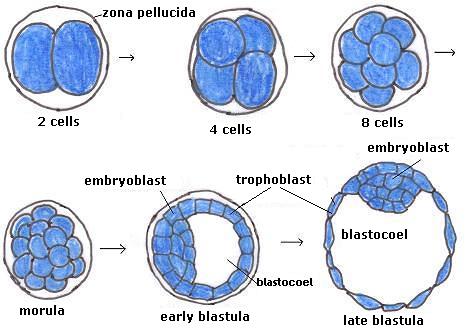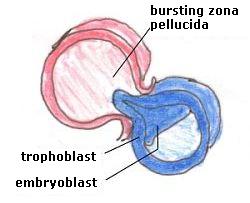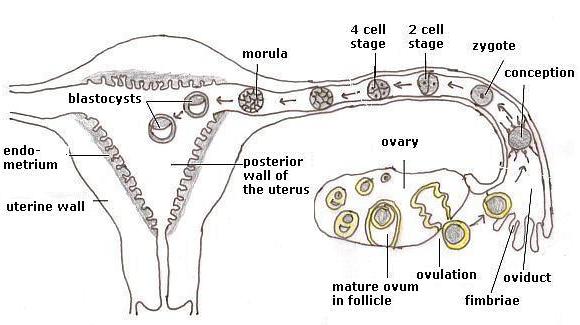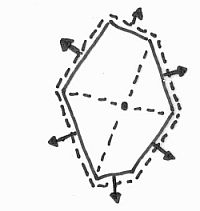
Man does not become human,
but is always human.
Erich Blechschmidt
The first week: a floating and timeless existence
The first cell divisions
Once the egg and the sperm cell have fused, the nuclei fuse and the chromosomes form pairs. The zona pellucida closes, so that no more sperm cells can connect with the egg. The zygote (= fertilized egg) has come into being. For a few days there is no exchange of nutrients and other substances with the environment.
The unicellular zygote exists for about one day. Then the cell divides itself into two equally big cells. Then they divide again every 16 to 20 hours. First there are four, then eight, then sixteen cells. On the fifth day there are about 32 cells and then about 64, the divisions are no longer synchronized. The stage of 16 to 64 cells is called a morula (= mulberry, the zygote resembles a mulberry or a blackberry).

Figure 8. The divisions of day 1 - day 6
1st row: The zygote consists of two cells after 24 hours, these divisions are regular: 4 and 8 cells, around the zygote is the zona pellucida;
Second row: after about 96 hours (5 days) there are 32 cells, the morula has arisen; early blastula with embryoblast and trophoblast on day 6; late blastula on day 7 without zona pellucida.
The last two drawings are cross-sections. The colour has no meaning.
On the sixth day, most cells migrate to the periphery (called the trophoblast (= nutritive tissue)) and a clump of cells stays inside (called the embryoblast (= embryonic tissue)). The trophoblast cells move closer to one another which makes the tissue firmer. The divisions continue. On the sixth day, there are approximately 120 cells, of which some 10 form the inner embryonic cell mass and about 110 the outer trophoblast, the ratio is about 1 : 10.
the time is variable, it can be one day earlier or later
All divisions occur within the shell of the zona pellucida. The embryo does not grow. The cells become smaller after each division and contain relatively less cytoplasm and more nuclear material.
As this happens, the embryo floats passively on the stream of fluid in the oviduct as it is transported to the uterus.
See also: www.embryology.ch
Hatching
On the sixth day when the zygote is in the uterus, the zona pellucida breaks through. This happens because in the trophoblast on the side of the blastocoel enzymes are formed that make the zona pellucida softer. Simultaneously the embryo expands to 2 times its volume, then contracts to 50% and expands again to 3 times its volume. Then the zona pellucida breaks open and the embryo bulges out of its shell. This "first birth" is called hatching and can be compared to the hatching of a chicken (Fig. 9). The embryo is now out of its rigid zona pellucida and can start to grow.
The release of the embryo from its shell is an active process of the embryo itself. The softening of the zona pellucida, together with the expansion, cause a break which enables the embryo to bulge out.

Figure 9. The zona pellucida breaks open on the side of the blastocoel of the blastula and bulges outward
Length of time
Remarkably, the development of the zygote up to the blastula stage is more or less the same in all mammals; it lasts approximately one week. This is not only the case in humans, with their embryonic development of 9 months, but also in mice with a development time till birth of 21 days and the elephant (21 months): the first phase up to the blastula of all of them lasts 6 days. For the rest of the development of mice there are only about 15 days left.
Roe deer have an extended gestation time. The rut takes place in July/August. The zygote develops into a blastula and then rests for approximately 150 days, this is a so-called embryopause. No earlier than in December the development goes on with an implantation. After a further development of 144 days the two fawns are born in May/June. The roe deer is the only ungulate in which this process takes place, but an extended gestation period is also seen with mustelids (including the badger), bears and kangaroos. The embryopause always takes place at the end of the first week in the blastula stage of the embryo, before implantation.

Figure 10. The uterus, fallopian tube and ovary.
In the ovary the stages of the maturation of the egg cell are shown. In the fallopian tubes the first cell divisions have been drawn as well as the places where they approximately take place.
Characteristics
The first day after conception, a human is (or better: we are) a large round cell. That's all we are, there is no more, but no less either. It seems a perfect life: the one-cell human organism is an entity and the one cell includes everything. The zygote is round and floats. We can easily see that the entity is first and the parts come later. A human is not built from cells of organs, a human divided into cells and into organs.
After the first day there are divisions and after 6 days the blastula is formed: a sphere with an interior space. The embryo has no direction: left and right, up and down are not yet concepts to describe it. Directions come later.
Immediately after the conception the zona pellucida closes and there is no interaction with the environment. After 6 days of cell divisions the cells become very small. There is now more nuclear material and less cytoplasm than on the first day, which decreases the inner activity of the cells. The embryo has become more structured compared to the zygote. It has now more the structured quality of the sperm, the inner mobile egg quality from the first day has diminished. Indicative of this is that the morula is easier to freeze than the egg (the sperm is also easy to freeze).
This process of dividing, at the same time as the cells are shrinking, cannot continue because the cells would become too small and the embryo would become rigid and die. There must be a reversal. This reversal is brought about by the blastula expanding and contracting and finally bulging out of the zona pellucida. Then it can absorb nutrients and start to grow and the cells can grow too. The embryo will make contact with the uterine wall and its development can continue. Estimates are that this process occurs with only 50 to 70% of the embryos.
In mammals the development of the embryo until the implantation takes 6 days. In the rest of the time of the embryonic development the differences are big: from 15 days to 21 months. The duration of the development of all mammals to the blastula has its own time and is not species-specific. It is not part of the life of the animal, it has its own life. It is as if (species related) time has not yet arrived.
Summary of the first week
- The embryo is a sphere, there are no directions.
- The development is set within the seclusion of the zona pellucida.
- Entity or unity comes first, multiplicity comes later.
- The duration of the development in the first week is fixed and equal for all species of mammals.
Characteristics of the mineral are, that it falls apart into the same elements; there is no communication with the environment and there is no time. The first week of the embryo can therefore be called the "mineral human being".

Figure 11. The mineral or a picture for the "mineral human" (from van der Wal (2003): Hartmann)
The mineral is split into equal components, there no communication with the environment and no time.
